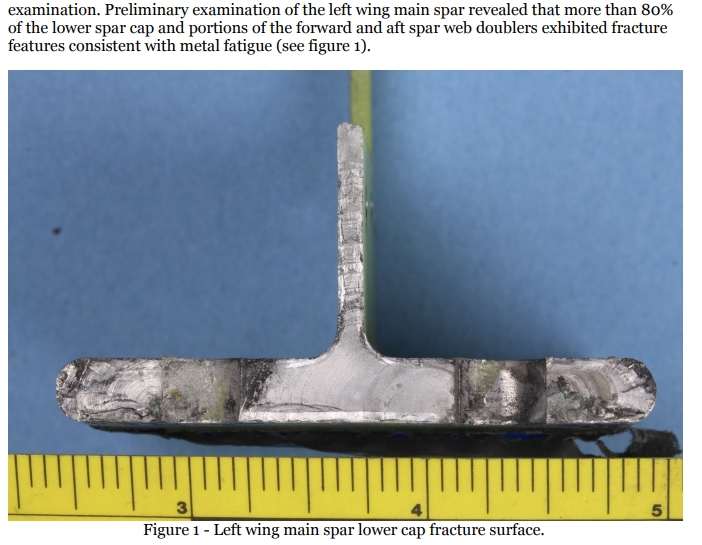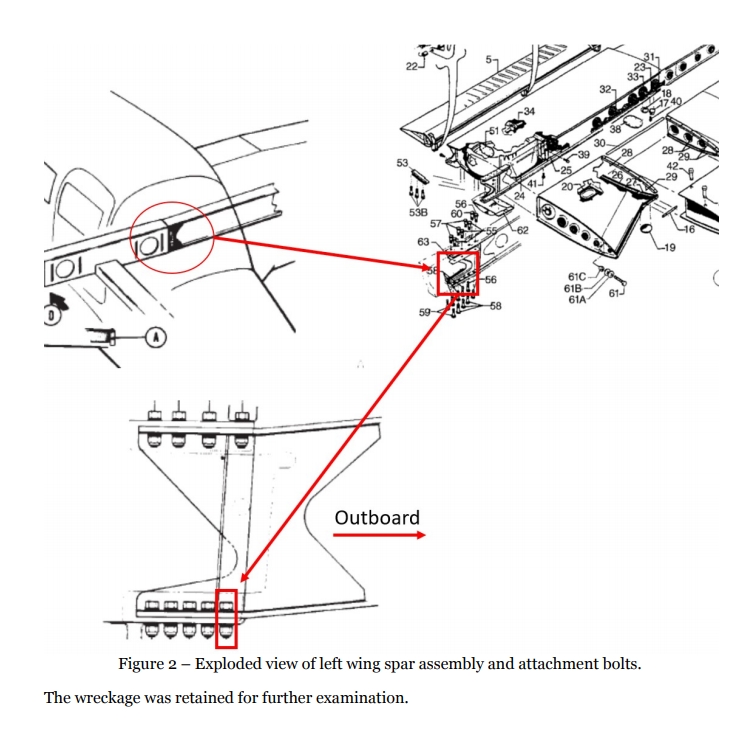
ASN Wikibase Occurrence # 208783
This information is added by users of ASN. Neither ASN nor the Flight Safety Foundation are responsible for the completeness or correctness of this information.
If you feel this information is incomplete or incorrect, you can submit corrected information.
| Date: | Wednesday 4 April 2018 |
| Time: | 09:53 |
| Type: |  Piper PA-28R-201 Arrow III |
| Owner/operator: | Embry-Riddle Aeronautical University |
| Registration: | N106ER |
| MSN: | 2844137 |
| Year of manufacture: | 2007 |
| Total airframe hrs: | 7662 hours |
| Engine model: | Lycoming IO-360-C1C6 |
| Fatalities: | Fatalities: 2 / Occupants: 2 |
| Aircraft damage: | Destroyed |
| Category: | Accident |
| Location: | SW of Daytona Beach International Airport (KDAB), FL -
 United States of America United States of America
|
| Phase: | Initial climb |
| Nature: | Training |
| Departure airport: | Daytona Beach International Airport, FL (DAB/KDAB) |
| Daytona Beach International Airport, FL (DAB/KDAB) | |
| Investigating agency: | NTSB |
| Confidence Rating: |
An airline transport pilot and a private pilot were performing commercial pilot checkride maneuvers, which included a touch-and-go landing at Daytona Beach International Airport, Florida. After the landing and during the climb, the airplane's left wing separated near the wing root and the airplane collided with terrain. The airplane's radar-derived ascent and heading profile following the touch-and-go maneuver was consistent with the airplane maneuvering in a manner that wouldn't reasonably be expected to produce airframe loading that would result in an in-flight structural failure. The airplane was operating under the maximum allowable gross weight and within its center-of-gravity limits at the time of the accident. According to automatic-dependent surveillance broadcast data, the airplane's radar target was last recorded at an altitude of 900 ft mean sea level (msl) and a groundspeed of 80 knots. Witnesses within 1/4 mile of the accident site reported that the airplane climbed "normally" on a westerly heading when they saw the wing separate from the fuselage.
Metallurgical examination of the accident airplane's left-wing main spar lower cap found that it exhibited fracture features consistent with fatigue through more than 90% of the cross-section, reducing its residual strength capabilities almost completely. The examination identified three fatigue cracks in the left-wing main spar lower cap. One fatigue crack initiated near the lower forward corner of the outboard forward wing attachment bolt hole (designated as bolt hole LC-1) and propagated forward to the forward edge of the cap. A second fatigue crack initiated near the lower aft corner of bolt hole LC-1 and propagated aft toward the lower aft wing attachment bolt hole (designated as bolt hole LD-1) and up the cap web almost to the edges. A third fatigue crack initiated near the lower aft corner of bolt hole LD-1 and propagated aft almost to the aft edge of the cap. Fatigue cracks also originated in the forward and aft doublers from both sides of the bolt holes.
A small fatigue crack was also identified in the accident airplane's right-wing main spar lower cap; however, that crack had not progressed to the point of failure. Examination of the left-wing main spar of another Piper PA-28R-201 owned and operated by the same operator as the accident airplane; manufactured in the same year with a serial number two previous to the accident airplane; and with similar hours, cycles, and operational exposure found a similar fatigue crack that initiated near the lower forward corner of hole LC-1.
The accident airplane was manufactured about 10 years before the accident and had been used solely for flight instructor and commercial pilot training by the flight school operator. The airplane had accumulated 7,690.6 hours and 33,276 landing cycles before the accident flight, which equates to 4.33 landing cycles per hour of flight time. According to operator personnel, the commercial flight lesson times averaged 1.4 to 1.8 hours; most of that time the airplane was being operated in the airport traffic pattern, performing takeoffs, landings, and power-off 180º maneuvers. While in the airport traffic pattern, the airplane operated between 1,000 ft agl and ground level. On longer flights, necessitating the need to operate in the practice area, maneuvering typically took place between 2,500 and 3,000 ft msl before returning to the airport.
A review of the operator's airframe discrepancy log for the life of the airplane and flight crew safety reporting system for the 24 months preceding the accident found some reported flap extension overspeed, gear extension overspeed, and hard landing events. In each case, the events resulted in airframe examinations during which no defects were noted by maintenance personnel. Interviews with flight instructors did not yield any safety of flight issues or critical airframe or loading exceedances caused by pilot operation that would be expected to precipitate cracking.
Probable Cause: Extensive fatigue cracking in the left-wing main spar lower cap and doublers, which resulted in the in-flight separation of the left wing. The fatigue cracks initiated and grew to a critical size due to flight and ground loads associated with flight-training involving flight-training maneuvers, significant operation at low altitudes and frequent landing cycles. Previously established inspection criteria were insufficient to detect the fatigue crack before it grew to a critical size.
Accident investigation:
 |
|
Sources:
NTSB
https://flightaware.com/live/flight/N106ER
Location
Images:




Photo: NTSB
Media:
Revision history:
| Date/time | Contributor | Updates |
|---|---|---|
| 04-Apr-2018 15:08 | Geno | Added |
| 04-Apr-2018 15:18 | Geno | Updated [Total fatalities, Total occupants, Source, Narrative] |
| 04-Apr-2018 15:32 | Iceman 29 | Updated [Time, Source, Embed code, Narrative] |
| 04-Apr-2018 15:53 | Geno | Updated [Aircraft type, Operator, Phase, Nature, Departure airport, Embed code, Narrative] |
| 04-Apr-2018 15:54 | Iceman 29 | Updated [Embed code] |
| 04-Apr-2018 16:00 | Iceman 29 | Updated [Embed code] |
| 04-Apr-2018 16:09 | Geno | Updated [Aircraft type] |
| 04-Apr-2018 19:24 | Iceman 29 | Updated [Source, Embed code, Narrative, Photo, ] |
| 04-Apr-2018 19:27 | Iceman 29 | Updated [Time, Embed code] |
| 04-Apr-2018 19:52 | Anon. | Updated [Registration, Cn, Source] |
| 04-Apr-2018 20:34 | Geno | Updated [Phase, Destination airport, Source] |
| 05-Apr-2018 03:24 | Iceman 29 | Updated [Source, Photo, ] |
| 05-Apr-2018 07:40 | bovine | Updated [Source] |
| 06-Apr-2018 06:04 | V2plus10 | Updated [Phase, Source, Narrative] |
| 06-Apr-2018 16:24 | Aerossurance | Updated [Operator, Location, Narrative] |
| 06-Apr-2018 19:46 | V2plus10 | Updated [Source, Narrative] |
| 19-Apr-2018 17:54 | Iceman 29 | Updated [Source, Narrative, Photo, ] |
| 19-Apr-2018 17:55 | Iceman 29 | Updated [Photo, ] |
| 05-Sep-2019 20:42 | Captain Adam | Updated [Departure airport, Destination airport, Source, Narrative] |
| 08-Sep-2019 08:48 | ASN Update Bot | Updated [Time, Operator, Country, Departure airport, Destination airport, Source, Embed code, Narrative, Accident report, ] |
| 08-Sep-2019 14:13 | harro | Updated [Country, Departure airport, Destination airport, Source, Embed code, Narrative, Photo] |
Corrections or additions? ... Edit this accident description
The Aviation Safety Network is an exclusive service provided by:


 ©2024 Flight Safety Foundation
©2024 Flight Safety Foundation